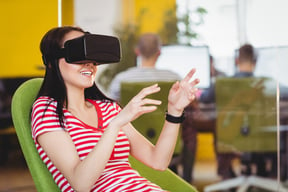Virtual and augmented reality made a significant impact in 2018. As both technologies continued advancing, adoption rates increased while consumers interacted with both features in everyday appliances and applications. No longer mutually exclusive, and with both poised to continue growing in popularity and commercialization, what is the reality of these mixed realities in 2019?
 Virtual and Augmented Reality
Virtual and Augmented Reality
While there’s no denying that augmented reality and virtual reality have revolutionized the way consumers interact with their environments, the two, at their cores, are fundamentally different. With augmented reality, consumers can view their surroundings alongside virtual elements. Virtual reality, on the other hand, eliminates the physical environment and places the consumer in a fully immersive world.
Applications
With augmented reality, innovative applications were developed that enhanced GPS systems and allowed users to play games like the wildly popular Pokémon Go. In the virtual reality space, devices like the Oculus Rift have commercialized the technology, significantly altering the way consumers experience content. In another example, companies have employed these technologies to improve the way they train their staff.
Once viewed as separate, today’s virtual and augmented reality have developed a near symbiotic relationship. Working in concert, mixed reality technology is transforming the way consumers interact each other and has transcended a variety of industries.
Mixed Reality
A combination of the two former technologies, mixed reality infuses a consumer’s real environment with an overlay of interactive virtual objects. Innovative in that it marries the functionality of already impressive tech, many industries are looking to utilize mixed reality in 2019 to enhance their operations.
Applications
The reality of mixed reality is that it will undoubtedly change the way consumers collaborate. From a business standpoint, products like Microsoft’s HoloLen’s enable remote assistance across a variety of industries and industrial settings. More examples of mixed reality collaboration can be seen when examining case studies regarding industry 4.0 and design capabilities. By equipping technicians with the tools to be able to seek expert advice while remaining hands-on and enabling the expert to see what the technician sees, tasks are completed faster and with less human error.
Given virtual and augmented reality share a projected worth of $108 Billion by 2021, it’s safe to say mixed reality technology will also amass a similar valuation. As mixed reality solutions become preferred, it’ll be important for OEMs to recognize the opportunity in producing the devices capable of running this transformative technology. To ensure your staff produce in accordance with industry standards and are eligible to capture this growing share of the market, contact the knowledgeable professionals at EPTAC, today.
About EPTAC
For over 30 years, EPTAC has been a leading provider of solder training and IPC certification. We provide professionals with the tools and training they need to advance their careers and improve their businesses. With 15 locations across North America, our solutions and instructional staff provide easy access to knowledge that will enhance your business model and help you meet and exceed industry demands. For more information call 800.643.7822 or contact us.